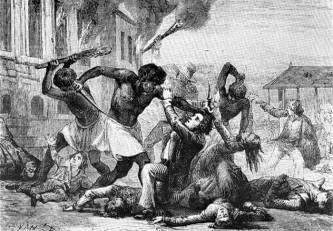Scholars of slavery usually make the distinction between actively rebelling and "passively" rebelling. Slaves rarely actively rebelled, because frankly the antebellum South was practically a military garrison due to its slave patrols and militias. While white southerners insisted that their "darkies" were contented and docile creatures, they were not going to take any chances. Especially after St. Domingue (the Caribbean slave revolt that resulted in the creation of Haiti), whose specter would haunt the minds of many antebellum whites for decades.
The largest slave rebellion to take place in the United States is illustrative of this point. When Nat Turner rebelled in the summer of 1831 in southeastern Virginia, his original band had but 7 men. At its height, his band had maybe 40 men. Within a few days of the outbreak of the insurrection, some 3,000 men had converged on Southampton County in order to put down the rebellion. The odds were greatly stacked against the slaves, both in terms of manpower and armaments. And the slaveholders made sure to keep it this way. In reprisal many completely innocent blacks, slave and free alike, were killed by vengeful whites. The body count for this rebellion was some 60 whites and 250 blacks, so that goes to show the depth of southern white commitment to the preservation of the slave system. Armed rebellion, as you can see, was a very risky and costly proposition.
But just because there were relatively few actual armed rebellions does not mean slaves just accepted their lot. Slaves would resist in other ways, such as faking sickness, breaking farm tools, killing livestock, working at a slower pace when the overseer was not around, stealing produce or materials from the master, running away, etc. This type of resistance, while carrying its own risks, was at least not guaranteed to get you killed.
https://www.quora.com/Why-didnt-the-slaves-rebel-in-the-USA

There were more whites so it was difficult for the slaves to rebel.
ReplyDeleteOnek Kichu jana gelo...
ReplyDelete